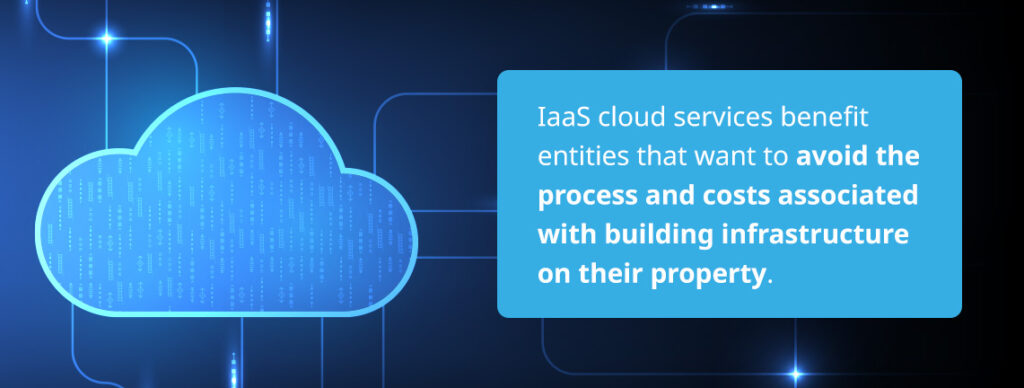
What Are the 3 Types of Cloud Computing Services?
Cloud computing refers to delivering services online, including servers, databases, analytics, software and networking. The internet allows businesses instantaneous access to their data or resources. Rather than owning their computing infrastructure or data center, companies can rent access to applications, storage and other services. Switching to the cloud allows businesses to save on costs and technical challenges.
Cloud Computing Models
There are three different methods for deploying cloud computing.
- Cloud: Cloud computing service models exist entirely online. These applications either originate in the cloud or migrate from another source. Cloud deployment models can use low-level infrastructure or high-level services to eliminate the need for scaling, architecture and management of on-premise infrastructure.
- Hybrid: Hybrid deployment models balance cloud-based and existing resources to extend or grow a business’ infrastructure and provide reliable services.
- On-premise: The on-premise deployment model uses on-site infrastructure to provide services. However, it doesn’t have the primary benefits of cloud computing, such as reducing overhead and eliminating the need for on-site infrastructure. However, companies may still choose it when looking for dedicated resources.
These three solutions offer distinct advantages. They can also combine to create a comprehensive solution for businesses. Below, you’ll learn more about the different cloud computing service models and their unique benefits.
Infrastructure as a Service
IaaS provides infrastructure on demand, delivering storage, network and computer resources through the internet on a pay-as-you-go basis. In this cloud service model, your provider hosts the infrastructure you’d find in a traditional on-premise data center, including servers, storage and networking hardware. Some of the following IaaS resources allow businesses to work from the cloud.
- Computer resources: IaaS uses virtual machines to compute resources managed by hypervisors. This cloud computing service will allocate VMs based on GPU, CPU and memory consumption based on your business’ workload. You can auto-scale or balance different workloads depending on your performance goals.
- Physical data centers: IaaS uses numerous robust services worldwide to provide scalable and on-demand computing services. Providers supply these components as a service rather than users having to interact with them directly.
- Storage: IaaS has diversified storage technologies, including block, file and object storage, which is easily accessible and resilient.
- Networks: IaaS can manage network hardware, including routers and switches.

IaaS cloud services benefit entities that want to avoid the process and costs associated with building infrastructure on their property. Businesses can also save money by paying only for the resources they use. However, there are some drawbacks to consider.
- Challenges managing new technology
- Need for team training
- Data security issues associated with the multi-tenant infrastructure of IaaS
- The potential of being unable to access data during vendor outages
Platform as a Service
PaaS differs from IaaS because businesses rent everything from a provider to build an application, including operating systems and infrastructure. The provider will handle the back-end management, simplifying web application development, while users work with the apps and data running on the platform. Companies can access PaaS with a simple internet connection, letting them build their necessary applications remotely through any web browser.
PaaS is often a good choice for businesses that want to avoid managing and purchasing software licenses. Developers can focus on critical tasks while the provider handles everything within the application life cycle. Environments with numerous developers can use PaaS to streamline workflows.
PaaS cloud computing services also add more value to the cloud since they can lower costs and reduce management overhead. You can easily scale your services and innovate on demand.
However, PaaS has some disadvantages.
- Potential data security challenges
- Compatibility issues with PaaS solutions, since not every component can be cloud-enabled
- Reliability, support and speed will depend on the vendor
Software as a Service
A cloud service provider manages SaaS while delivering software applications. Generally, businesses access SaaS cloud computing services through a web application. The user typically handles bug fixes, software updates and other general maintenance. The benefits of SaaS include reducing the need to install applications individually and making it easier for teams to use the software they need for their jobs.
Since SaaS providers license software, customers can lease applications such as email, calendaring, document management, resource planning and customer relationship. SaaS benefits companies that need to launch their applications quickly and lack the time to set up the software or servers themselves.
Despite these benefits, there are also some potential shortcomings of SaaS.
- Solutions require network connectivity
- Limited solution ranges
- Loss or lack of control

Contact Contigo for Your Cloud Management
By understanding the possible advantages and drawbacks of various cloud computing services, you can make an informed choice for your business.
If you’re looking for a cloud computing solution, Contigo Technology can help you find what you’re looking for, whether it scales with your business or offers flexibility. We manage the complexities of cloud computing and management, so you don’t have to. Our team can help you navigate the different options and give you peace of mind, ensuring you’re optimizing your performance and meeting your compliance and security needs.
We offer a wide range of services to benefit your business, connecting you with the cloud computing service that makes the most sense as you grow. Contact us today to learn more about our cloud computing and management services and how we can revolutionize your operations.